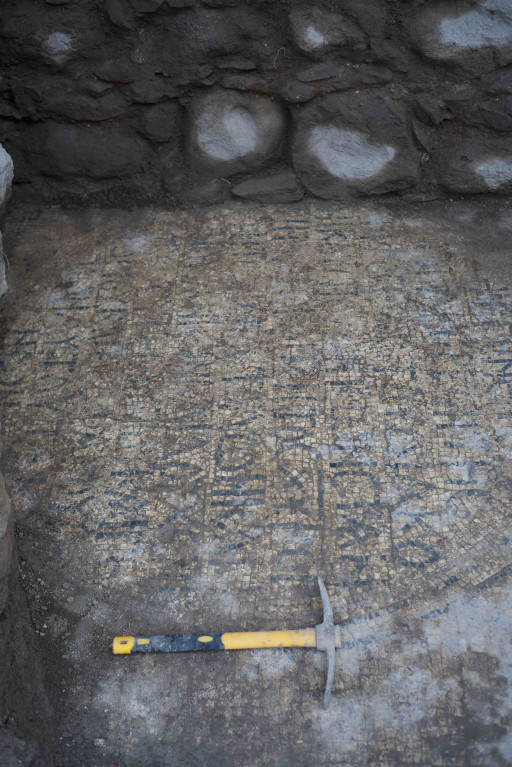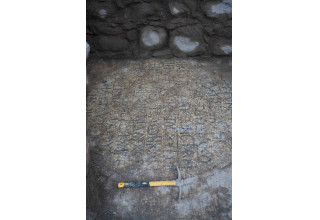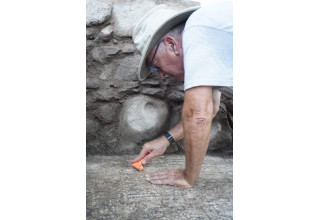Galilee, Israel - August 10, 2022 - (Newswire.com)
Archeologists from Kinneret College in Israel and Nyack College, NY, led by Prof. Mordechai Aviam and Prof. Steven Notley, have uncovered a large Greek inscription during excavations of what is being called the "Church of the Apostles," a Byzantine period basilica at el Araj/Beit haBek believed to be built over the Apostles Peter's and Andrew's home. The inscription was translated by Prof. Leah Di Segni (Hebrew University) and Prof. Yaakov Ashkenazi (Kinneret College). It references a donor, "Constantine, the servant of Christ," and continues with a petition for intercession by St. Peter, "chief and commander of the heavenly apostles." Framed with a round medallion made of two lines of black tesserae, the inscription forms part of a larger mosaic floor in the church's diaconion (sacristy) that is partly decorated with floral patterns. The el Araj/Beit haBek site is located in the Beteiha nature preserve, and assistance was made by the Israel National Parks Authority. The El Araj Excavation Project is a joint project of the Kinneret Institute for Galilee Archeology at Kinneret College and Nyack College. The excavation is sponsored by the Center for the Study of Ancient Judaism and Christian Origins (CSAJCO), the Museum of the Bible, the Lanier Theological Library Foundation, and HaDavar Yeshiva (HK).
The title "chief and commander of the apostles" is routinely used by Byzantine Christian writers to refer to the Apostle Peter. "This discovery is our strongest indicator that Peter had a special association with the basilica, and it was likely dedicated to him. Since Byzantine Christian tradition routinely identified Peter's home in Bethsaida, and not in Capernaum as is often thought today, it seems likely that the basilica commemorates his house," said Steven Notley, academic director of the dig.
This discovery also bolsters the basilica's identification with the church described by the 8th century bishop of Eichstätt, Willibald, who reported that it was built over the house of Peter and Andrew.
"One of the goals of this dig was to check whether we have at the site a layer from the 1st century, which will allow us to suggest a better candidate for the identification of Biblical Bethsaida. Not only did we find significant remains from this period, but we also found this important church and the monastery around it," says archaeologist Mordechai Aviam, archaeological director of the excavation.
The Roman remains that have been excavated bear witness to the testimony of Flavius Josephus (Jewish Antiquities 18:28) that the village became a small polis called Julias that existed until the 3rd century CE. Altogether, these finds continue to strengthen the identification of el Araj/Beit haBek with the ancient Jewish village of Bethsaida.
Excavations will resume in October when the cleaning of the entire church will be completed with the aim to answer the question of its different phases and perhaps uncover additional inscriptions.
To learn more about the dig, or join in the excavations next season, click here.
BACKGROUND ON THE DIG:
During this season, students from Kinneret College, as well as volunteers from the USA, Canada, Hong Kong, Slovakia, Brazil, and the UK participated in the excavation. Efforts were concentrated on the area in and around the church, which was named by the excavators, "the Church of the Apostles," due to Willibald's description of his pilgrimage to the Holy Land. While traveling from Capernaum to Kursi he stayed overnight at a place he was told, "is Bethsaida from which came Peter and Andrew. There is now a church where previously was their house." Simon Peter was the first to declare the messiahship of Jesus (Matthew 16:16) and so was considered chief of the Apostles. His prominence is demonstrated by the church of St. Peter in Rome that was built over his grave. It seems his home was likewise commemorated in Bethsaida.
Contact: Dr. R. Steven Notley, notley@gmail.com, 845-300-5797
Related Images
Press Release Service by Newswire.com
Original Source: New Inscription With Petition for Intercession by Apostle Peter Discovered at the Suggested Biblical Bethsaida








